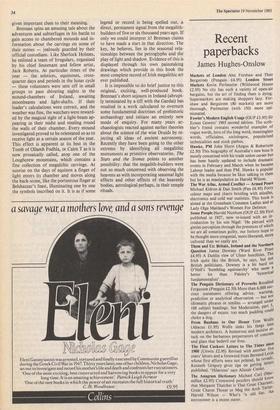Fairy fingers
John Michell
The Stars and the Stones Martin Brennan (Thames & Hudson £12)
Martin Brennan is a New York artist who studied Shintoism in Japan and was advised by his teachers there to go to Ireland, the land of his parents, to in- vestigate prehistoric monuments and rock carvings. He took lodgings near Newgrange, one of the three great chambered mounds by the River Boyne just north of Dublin, and entered vigorously in- to the small but disputatious world of Irish archaeology.
Newgrange is so constructed that at the moment of midwinter sunrise, on the shortest day of the year, a thin sunbeam penetrates 62 feet down its stone-lined en- trance passage and briefly illuminates the interior chamber. According to Brennan, local people had known about the mid- winter illumination since the 19th century, and it was referred to by the mystical poet, George Russell; but it was not acknowledg- ed by archaeologists until 1969 when Michael O'Kelly, the excavator of Newgrange, observed it for himself. Even then, many of his colleagues remained scep- tical, and the possibility that similar light effects might have been built into other mounds was not even considered. Thus a great deal of thoughtless excavation has been permitted, destroying original details of the mound structures which might have given important clues to their meaning.
Brennan spins an amusing tale about the adventures and subterfuges in his battle to gain access to chambered mounds and in- formation about the carvings on some of their stones — jealously guarded by their official custodians. Like Sherlock Holmes, he enlisted a team of Irregulars, organised by his chief lieutenant and fellow artist, Jack Roberts. At particular times of the year — the solstices, equinoxes, cross- quarter days and periods in the lunar cycle — these volunteers were sent off in small groups to pass shivering nights in the mound-chambers of Ireland, awaiting moonbeams and light-shafts. If their leader's calculations were correct, and the weather was fine, the watchers were reward- ed by the magical sight of a light-beam ap- pearing in their midst and stealing round the walls of their chamber. Every mound investigated proved to be orientated so as to receive light at a certain season of the year. This effect is apparent at its best in the Tomb of 011amh Fodhla, or Cairn T as it is now prosaically called, atop one of the Loughcrew mountains, which contains a fine collection of megalithic carvings. At sunrise on the days of equinox a finger of light enters its chamber and moves along the back-stone, like the portentous finger at Beishazzar's feast, illuminating one by one the symbols inscribed on it. it is as if some
legend or record is being spelled out, a direct, permanent signal from the megalith- builders of five or six thousand years ago. If only we could interpret it! Brennan claims to have made a start in that direction. The key, he believes, lies in the seasonal rela- tionships between the petroglyphs and the play of light and shadow. Evidence of this is displayed through his own painstaking drawings which provide in this book the most complete record of Irish megalithic art ever published.
It is impossible to do brief justice to this original, exciting, well-produced book. Brennan's short sojourn in Ireland (abrupt- ly terminated by a tiff with the Gardai) has resulted in a work calculated to overturn some fundamental doctrines of prehistoric archaeology and initiate an entirely new mode of enquiry. For many years ar- chaeologists reacted against earlier theories about the science of the wise Druids by re- jecting all ideas of ancient astronomy. Recently they have been going to the other extreme by identifying all megalithic monuments as primitive observatories. The Stars and the Stones points to another possibility: that the megalith-builders were not so much concerned with observing the heavens as with incorporating seasonal light effects and other effects of the heavenly bodies, astrological perhaps, in their temple rituals.



























































 Previous page
Previous page